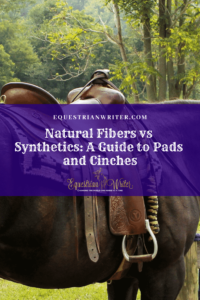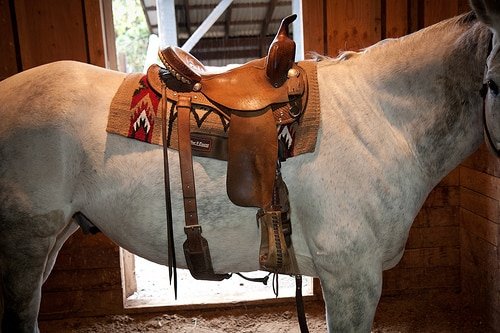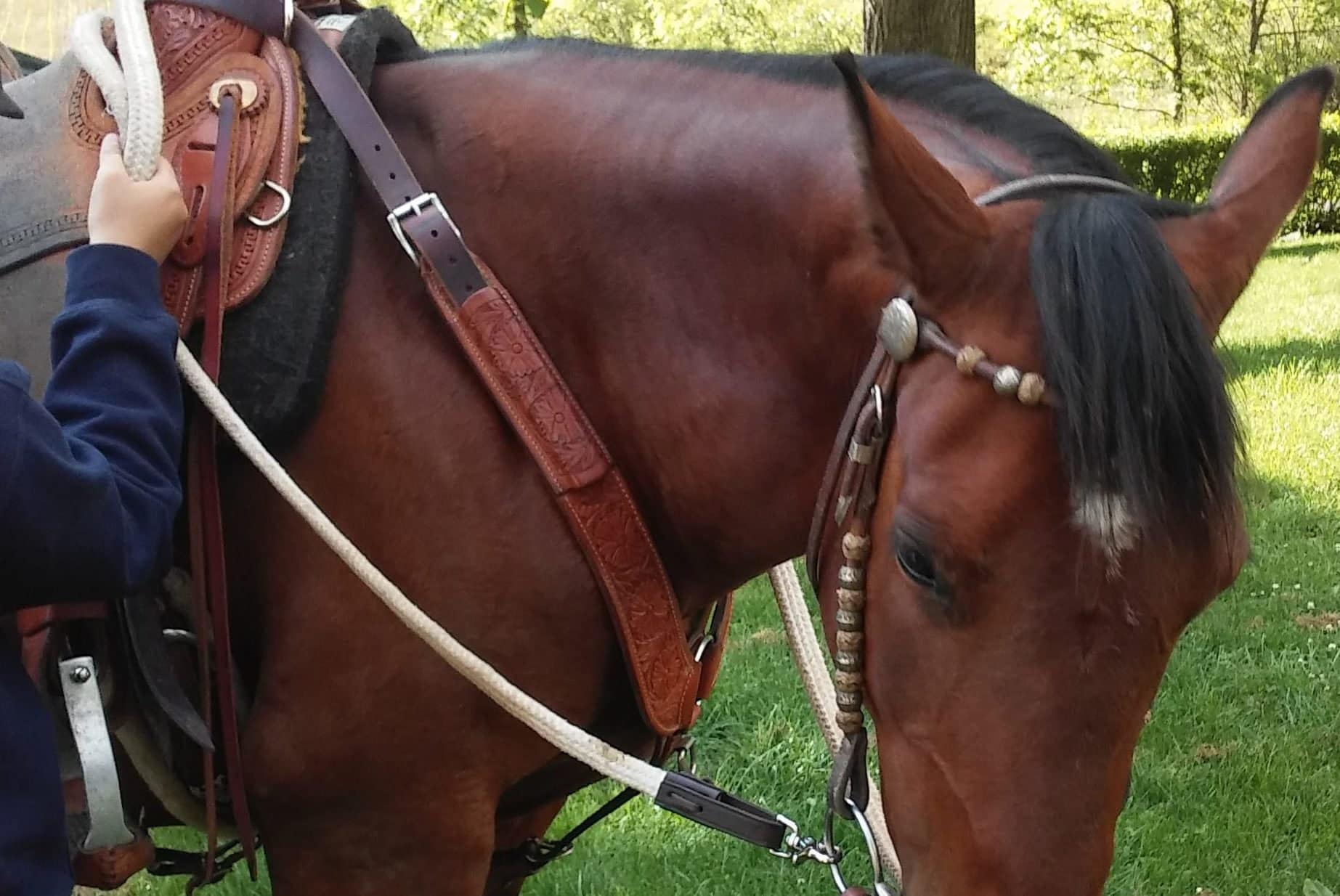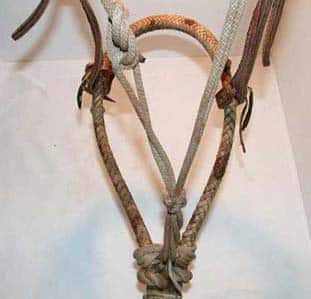

This is a long standing debate in the equine industry: natural fibers vs synthetics. With so many new technologies and synthetic materials being produced every day, the market is flooded with products. They promise everything from better saddle fit to shock protection and solutions to just about every other problem equine athletes encounter. With so many options it is difficult to sort through all the advertisement hype and know which options really are the best for your horse. Here is my tack shopping guide for saddle pads and cinches.
The Importance of Natural Fibers
The number one rule when tack shopping is to know what the products are made of. If you can’t find what they are made of, that probably means that they use substandard materials. So, what materials should you be looking for?
Quality tack should use natural fibers. For cinches we are talking about merino wool, shearling, alpaca fibers, or mohair. For saddle pads it is wool all the way. It can be wool felt or wool fleece, merino wool or shearling, but it’s got to be wool.
Tack that uses quality natural fibers, will always advertise it because they know what discerning customers are looking for. If you have to spend more than a few minutes trying to figure out if the fleece saddle pad you want is wool or synthetic, you’re usually guaranteed that it’s synthetic. Wool saddle pads advertise themselves as a “Wool Saddle Pad.”
Cinches
As previously stated, your options for quality cinch material are merino wool, shearling, alpaca fibers, or mohair. All of these fibers are great for wicking away moisture to keep your horse cool and comfortable. I personally ride in a merino wool cinch.
A quality cinch made of natural fibers will also slip less. Since I switched from neoprene to merino wool, I don’t have to pull my cinch nearly as tight. This, in turn, allows my horse to be much more comfortable and breath easier during the ride.
Neoprene
This is probably the most popular synthetic material for cinches. There are all kinds of neoprene cinches out there that advertise shock absorption properties and special waffle patterns that mimic the benefits of a natural cinch by allowing air flow. But here’s the deal, no synthetic cinch can hope to compete with the shock absorption, moisture wicking, or air flow properties of a wool, shearling, alpaca, or mohair cinch.
Leather Latigo or Nylon?
It is important to remember that the material of your cinch should determine what material you use for your latigo and off-side billet. A rule of thumb is that a synthetic cinch should always have a leather latigo and billet so that is has enough give to be comfortable for the horse. If you want to use a nylon latigo or billet, you need to make sure your cinch has enough give to compensate for the rigidity of the nylon. Nylon latigos and billets are best used with an alpaca or mohair cinch.
Girth Galls
Most horses who suffer from girth gall are ridden in synthetic cinches, more specifically, neoprene. These cinches chafe and sore a horse even when adjusted properly. Sure, there are plenty of horses that don’t get sore from them, but the damage isn’t always external. If you compete in an high-impact sport such as barrel racing, roping, or jumping, your horse needs all the help he can get when it comes to shock absorption. This is where a cinch made with natural fibers is vitally important.
Now, trail riders and weekend warriors in the pleasure ring need not panic and drop $80 on a new mohair cinch. If you are only participating in low-impact activities, have a well fitting saddle, and your horse isn’t getting girth galls, then you can get away with a synthetic-based cinch.
The cinch I use for trail riding is a merino wool cinch with nylon backing. Because of it’s design, the merino wool accounts for wicking sweat and preventing girth galls, however, due to the nylon backing, its shock absorption is on par with other synthetic cinches. This is fine for trails and low impact training. Once I get back into barrel racing however, I will be switching to either an alpaca or mohair cinch to get the benefits of better shock absorption.
On a similar note, many dressage girth is neoprene. It is extremely difficult to find a natural fiber dressage girth that won’t break the bank. I use a neoprene girth for my dressage saddle, however I cover it with a merino wool sleeve to protect from chaffing. This is ok for low level dressage. This would not be acceptable for jumping or other high-impact sports.
Saddle Pads
Your saddle pad is another piece of the puzzle for getting quality shock absorption. Many pads on the market today are 1/2 inch thick. This is not near thick enough to protect your horse’s back. I ride in no less than a 1 inch thick wool felt pad. Now, as long as the pad is real wool, either felt or fleece will do. The trick is verifying that the wool is at least 95% wool. It’s impossible to get 100% wool felt due to the demands of manufacturing, but the highest quality pads have 90% or greater with 95% being optimal. I have seen a lot of horses with well fitting saddles get saddle sores from a synthetic or high percentage synthetic blend saddle pad.
Synthetics
If you feel the underside of a synthetic saddle pad, it feels rough and unpleasant to touch. Sprinkle a little water on it. See how the beads of water sit on top of the fibers? That’s what happens to your horse’s sweat. Wool wicks the sweat away while many synthetics repel it back onto the horse.
The fibers also slide easily due to being slick and shiny. Try putting your synthetic saddle pad on under your saddle without doing up the cinch. Now try to slid the saddle on your horse’s back. That was pretty easy, wasn’t it? If it is that easy to slide, it’s not going to matter how tight you cinch that sucker, it’s going to slip at the most inopportune moment. Now try putting a wool saddle pad on and not tightening the cinch. How easy is it to slide that saddle around? Not very easy. Natural fibers have much better grip. If you have a wool saddle pad and a cinch with natural fibers, you won’t have to tighten that cinch near as tight. Those fibers will hold your saddle in place much better than any synthetic option.










Hi
Is there a way to repurpose a wool back girth with double elastic? The elastic is has lost its elasticity so I plan to buy a new one. Hate to waste real wool
I
I do love my mohair cinches and felt pads. However one of my horses has become allergic to wool. What now? The mohair cinch is still okay as I did verify the maker did not sneak any wool into into it – I heard some manufacturers might do that. What about the pad? I am thinking of trying a synthetic fleece pad. Do you think that would be the next best option.
I do love my mohair cinches and felt pads. However one of my horses has become allergic to wool. What now? The mohair cinch is still okay as I did verify the maker did not sneak any wool into into it – I heard some manufacturers might do that. What about the pad? I am thinking of trying a synthetic fleece pad.
Hello, I am getting away from neoprene all together. Got rid of my 5star wool pad and bought new JenX pad western trail (love it!). My question is, do you have a preferred cinch western pleasure/trail? Looking into merino lambskin or sheepskin. 3 makers of interest: horse dream importers western contour girth and Engel worldwide western girth, as well as Christ Lampskin western girth. Wondering if you know of any of these makers or your thoughts? Might go with Toklat, I dont know. Thanks for your time if you respond. I ride in a treeless Bob Marshal.
Hi Tammy,
I’m so sorry, I missed your comment until now. It’s probably too late, but in case you haven’t found one, here is the merino wool cinch I currently use: https://www.statelinetack.com/item/professionals-choice-merino-wool-cinch/E005702/. Here is an alpaca fiber cinch I use as well: https://www.statelinetack.com/item/mustang-pro-roller-alpaca-roper-cinch-30-brown/E003729%20030%20BRN/. Please note that the alpaca cinch needs to be purchased 1 size smaller than you would normally get as it will stretch. I do not have experience with any of the makers you listed. I don’t like contour girths as they seem very gimmicky to me. The research just isn’t there to back them up. I personally think simpler is better, but that’s my opinion. If your horse likes them, go for it. I don’t think they would necessarily hurt either.
Alexi